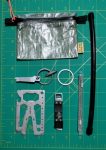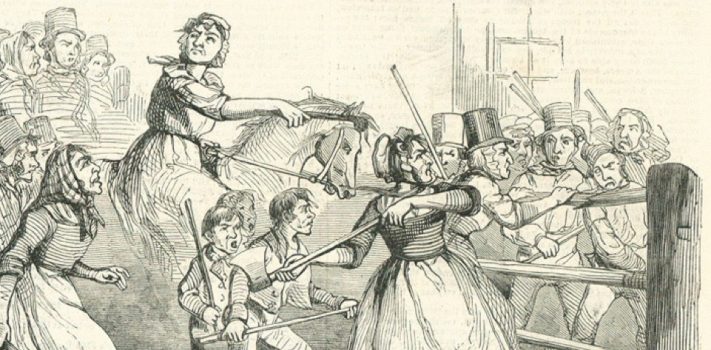(Continued from Part 2.)
I’ve also got a smaller kit with just some very basic tools that fits in a wallet-size pouch (except for the Shomer-Tec saw) and weighs just 2.2oz, not including the .7oz trauma shears since I’m already carrying those in my FAK. It consists of:
- Wazoo tube wire saw w/1 extra titanium split ring (for handles)
- Shomer-Tec diamond bow saw
- Lever Gear Toolcard Pro (wrenches, cord cutter, additional screwdrivers, pry bar)
- Big Design Titanium Pocket Bits (I replaced the OEM split ring with a titanium one)
- Small 2” file from old multitool (on same split ring as driver bit)
- CRKT Micro Tool & Keychain Sharpener
- 4” trauma shears (in my medical kit)
Here’s a picture of the small kit with the carrying pouch:
 In addition to tools you’ll want to have some materials to help you attach and hold pieces together when assembling improvised weapons. I always have some paracord, zip ties, 1” Gorilla tape, steel wire and ranger bands in a small pouch, along with a small tube of super glue. If you don’t want to or can’t carry any significant length of cordage, Grim Workshop makes a micro-tool (.2oz., $13) that allows you to cut strong cordage from a plastic drink bottle. I also usually carry a small WD-40 pen in case I need to loosen some stubborn parts.
In addition to tools you’ll want to have some materials to help you attach and hold pieces together when assembling improvised weapons. I always have some paracord, zip ties, 1” Gorilla tape, steel wire and ranger bands in a small pouch, along with a small tube of super glue. If you don’t want to or can’t carry any significant length of cordage, Grim Workshop makes a micro-tool (.2oz., $13) that allows you to cut strong cordage from a plastic drink bottle. I also usually carry a small WD-40 pen in case I need to loosen some stubborn parts.
Disorient/Distract/Disrupt Weapons
The first class of weapons I’ll cover are those that are designed to disorient, distract or disrupt an attacker and are typically effective beyond contact distance (thrown, sprayed, etc.). The goal with these weapons is to provide a short period of time for you to either quickly disengage from the attacker or to take additional action to further stop the threat. For example, if you can temporarily blind an attacker who’s charging you for a few seconds you can step towards them and deliver a debilitating kick to their groin or other sensitive area, giving yourself time to escape. The most obvious example of this is pepper spray, which may or may not be legal where you are. I prefer the ASP Metro and Sport devices, since an attacker can easily mistake them for a pen, e-cig or flashlight until it’s too late.
If you’re somewhere that doesn’t allow pepper spray there are a lot of alternative types of spray cans which when sprayed in someone’s face will cause anything from temporary discomfort to serious injury. Some options include:
- Hairspray
- Deodorant
- Glue (Elmer’s spray adhesive)
- WD-40
- Insecticide
- Mosquito repellent
- Spray paint
- Sunscreen (not the kid-safe stuff)
- Starter fluid
- Cleaning fluids (Armor All Tire Foam Protectant)
Note: Consult your state and local laws, and beware that you might be the target of a civil lawsuit if you cause any permanent injury to your opponent.
Many examples of these types of spray cans are available in 4oz. or smaller sizes, which are much easier to carry and deploy. Protecting your eyes is a basic human instinct, so even just spraying water at someone’s face will almost always cause a temporary distraction. Some of these items might cause raised eyebrows if you’re found to be carrying them, so make sure you can justify them to any security or law enforcement personnel. For example, if you’re bald you might have problems explaining why you’re carrying a can of hairspray, unless you’re with your significant other, in which case you’re just playing pack mule (as usual). Check the travel-size section of your local Walmart or drug store to find various small spray cans.
Most spray cans are designed to spray just a mist or a short distance, which means your attacker will need to be close to use them. You may be able to modify the nozzle to spray a longer stream by gently increasing the size of the nozzle opening with a micro drill bit – start small and try it out to figure out the optimal size. For the WD-40 you can cut a short length of the red tube that comes with the can to improve the spraying distance.
One potential issue with spray cans is that once they’re empty you can’t use them anymore, other than as something lightweight to throw at an attacker. A more flexible option would be to carry a small 2oz.-4oz. refillable spray or squeeze bottle and fill it with whatever irritating, noxious or caustic liquid is available. This can be any liquid such as ammonia, bleach, degreaser, hot sauce, dirty water, denatured alcohol, pepper powder dissolved in water or alcohol, urine, paint thinner, etc. – anything that can cause an attacker pain or discomfort.
Note that HDPE plastic bottles will have the greatest resistance to corrosive chemicals, but even those will eventually break down if you store something corrosive for a long period of time (days-weeks). You should buy some extra bottles and test various liquids that you might have access to to see what can be safely used. Another consideration is that a 2oz. squirt bottle will only give you 3-4 good ‘squirts’, so I also carry a 260ml (8.8oz.) titanium flask that normally contains denatured alcohol that I use in my small alcohol stove. In a longer-term emergency scenario I can empty the alcohol and fill it with a more effective liquid, which will give me around 4 refills for my squirt bottle. A small folding funnel is also recommended to reduce spillage when filling your spray/squirt bottle.
Other sprayer alternatives include squirt guns and oil can pumps, depending on what you think you can get away with carrying. The metal oil can pump is especially nice since you can use almost any kind of liquid and not worry about it dissolving.
Note: This is one of morally ambiguous areas that I mentioned earlier – some liquids can cause permanent damage like blindness, and if you use them when the rule of law is in effect you’ll probably end up in jail for a very long time, or sued out of much of your net worth. On the other hand, if you’re defending yourself from an attacker while trying to get home after a major large-scale disaster WROL it may be the only way to save yourself or your loved ones. It’s up to you to decide based on your situation and what liquid(s) you have access to.
If spraying a liquid at an attacker isn’t an option for you, you can also potentially blind them temporarily with an extremely bright light. One of my favorite EDC flashlights is the Nitecore Tip SE (1oz., $30) – it can put out 700 lumen with a single button click and hold. Some other good options include the Olight Arkfeld (3.1oz., $90), which can put out 1000 lumen by double-clicking the power button, the Monstrum Tracer (2.8oz., $70), and the Monstrum Tracer Pen (2.3oz., $70), which also put out 1000 lumen. I prefer the flat-style lights with the buttons on the side since at a quick glance it doesn’t look like a traditional tubular flashlight, which might give you an extra second or two before the attacker figures out what you’re doing and reacts, and I find the side buttons easier to manipulate. The brighter the light the bigger the impact it will have, so don’t plan on doing this with your 50 lumen keychain light. Another method of increasing the effectiveness of a light is to have a very powerful strobe function, which can disorient as well as blind an attacker – the Nitecore EDC27 (4.4oz, $90) is one example that provides a 3000 lumen strobe. You can also carry a small handgun weapon-mounted light (without the handgun, of course) – they’re very compact and many of them offer a very bright strobe function. The effectiveness of this technique depends on a number of factors – if you’re outside in bright sunlight or your attacker is wearing sunglasses it probably won’t be as effective.
In another potentially morally ambiguous area, closely related to using a flashlight is using a laser to blind your attacker. This has the advantage of being effective from a much greater distance than a flashlight, especially with blue or green lasers since your eyes are less sensitive to those colors and will react a lot slower. Note that any laser with less than 5mW of output will generally not cause any permanent damage unless your eye is directly exposed for a long time, and that covers the majority of the lasers sold in the US. It can however cause temporary blindness, which is the goal here. Even those cheap cat toy lasers you can buy at a dollar store for $10 can impact a person’s vision long enough for you to take action. Be aware that due to some idiots pointing lasers at airplanes, some governments have restricted or outright banned the possession of laser pointers. BTW – that Olight Arkfeld and Nostrum Tracer flashlights I previously mentioned both have a laser built-in. You should also take a look at the various weapon-mounted laser devices available for handguns – they’re super bright and compact, and you can trim the mounting brackets off so it doesn’t look like a weapons light or a standard laser pointer.
Particulate Matter
The next method of distracting or disrupting an attacker is through the use of particulate matter like sand, dirt, metal shavings, granular soap, salt, fertilizer, etc. thrown into the attackers face and eyes. As I mentioned earlier, all humans have an instinctive reaction to protect their face and head, so at a minimum you’ll force the attacker to pause and raise their hands. If you’re successful in getting it into their eyes, nose or mouth you may have up to a couple of minutes before they can function again, giving you time to either disengage or take additional actions. Heavier granules like coarse sand or salt tend to fly further than finer ones like talcum powder, although for closer distances you can create a good cloud of powder by squeezing a partially filled plastic bottle of powder like the 4oz. Gold Bond foot powder. You can also replace the contents of an innocuous plastic powder bottle with something like powdered Capsaicin pepper – it won’t give you the same range as a true pepper spray, but it can very effectively disrupt an attacker at close range. I always carry a small ziplock baggie with me so I can collect and carry any useful particulate matter I come across if I’m in a high-danger environment.
While powder is generally more effective since it can get in attackers eyes, nose, and mouth, larger items like a handful of coins or a collection of small rocks, screws, nuts or bolts thrown in an attacker’s face will still cause usually cause them to flinch and cover up, giving you a few precious seconds to take additional action.
(to be continued tomorrow, in Part 4.)










